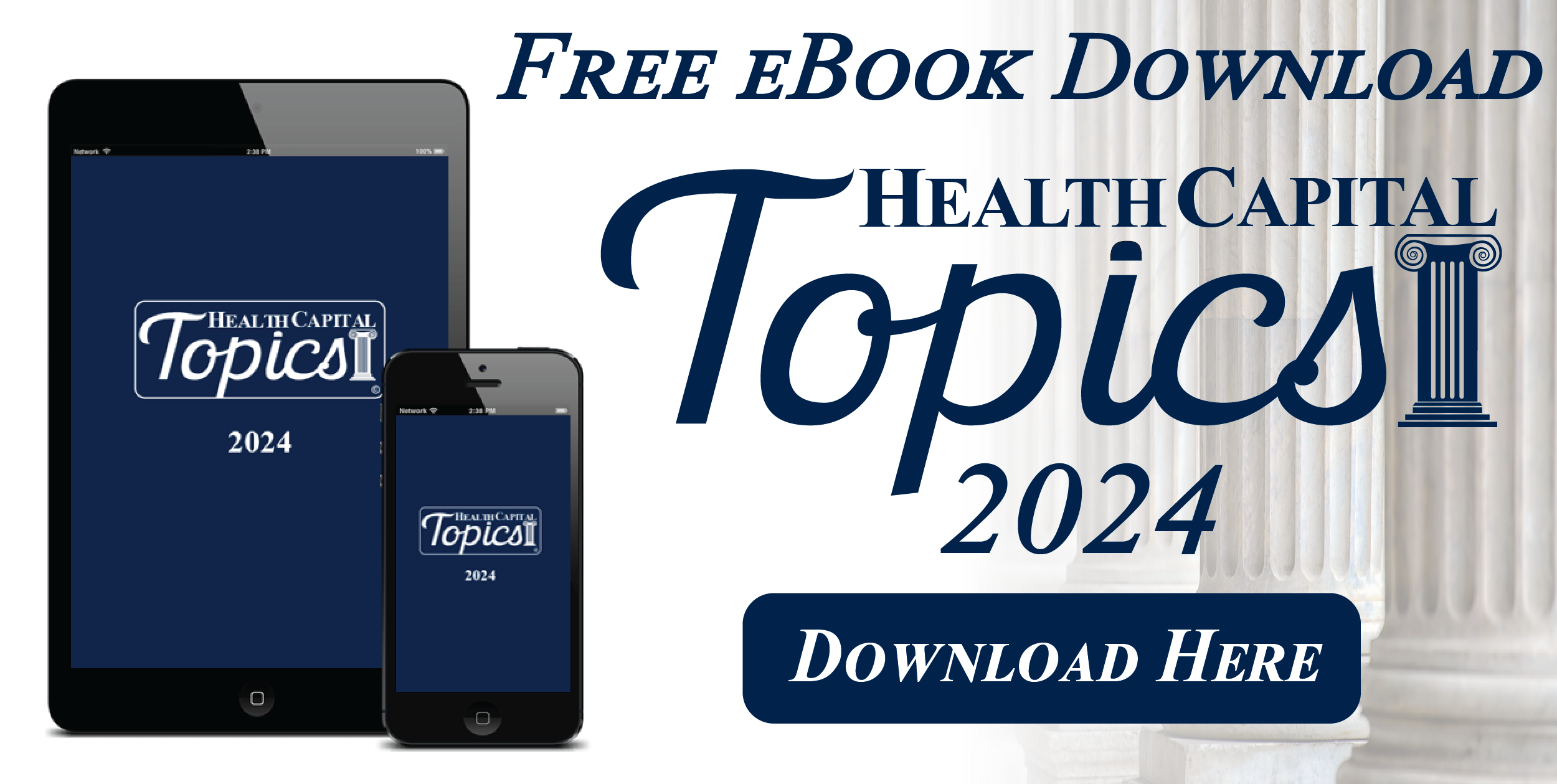Since lawmakers failed to pass a bill to fund the federal government before the September 30, 2025 deadline, lawmakers have remained deadlocked over the spending bill. The deadlock is centered on the continuation of health insurance exchange subsidies, but the shutdown has broader implications on the healthcare industry. This Health Capital Topics article provides an update on the continuing saga.
Congress passed the most recent temporary funding bill, known as a continuing resolution (CR), on March 14, 2025, funding the government through the remainder of fiscal year 2025, until September 30, 2025.1 While House Republicans unilaterally passed a stopgap measure extending funding until November 21, it failed in the Senate, where Democrats assert that they will not vote for a spending bill that does not protect healthcare access, including renewing the Affordable Care Act (ACA) marketplace enhanced premium tax credits and repealing the One Big Beautiful Bill Act (OBBBA) Medicaid provisions.2 Senate Democrats subsequently proposed an alternative stopgap bill to fund the government through October 31, permanently extend the ACA subsidies, and reverse the OBBBA Medicaid cuts; that bill also failed.3 Senate Republicans have a narrow majority, but require Democratic backing to meet the 60-vote threshold needed to pass an extension.
The ACA marketplace enhanced premium tax credits, which are provided to lower-income individuals to purchase health insurance on the ACA insurance exchanges, and have been in place since 2021, are currently set to sunset at the end of 2025.4 The Urban Institute estimates that if the ACA enhanced premium tax credits ultimately expire, 22 million Americans would see increased health insurance costs, and healthcare providers would lose $32.5 billion in revenue and take on an additional $7.7 billion in uncompensated care costs next year.5 Democrats pushed to include an extension to the tax credits in OBBBA, but were unsuccessful. OBBBA provisions also included over $911 billion in Medicaid cuts and new conditions on eligibility, which are expected to increase the number of uninsured people by 10 million.6 Notwithstanding the insurance subsidies, insurance premiums across the U.S. are expected to increase a median of 18% next year.7 This combination of increasing costs results in the largest price increase since the marketplaces were launched 12 years ago.8
In an interesting twist, the open enrollment on the ACA exchanges (which is expected to be directly impacted by the cost of those ACA insurance exchange plans over which lawmakers are arguing) begins November 1, 2025.9 In anticipation of the start of ACA exchange open enrollment – as well as Medicare open enrollment, which began October 15th – the Centers for Medicare & Medicaid Services (CMS) ordered its furloughed employees to return to work on October 27th, “in order to best serve the American people amid the Medicare and Marketplace open enrollment seasons.”10
In addition to the furlough of thousands of federal workers and significant disruption across the country, the shutdown resulted in the expiration of several healthcare program and policy extenders,11 including Medicare telehealth flexibilities, the hospital-at-home waiver, and community health center funding.12 This means that Medicare is not currently reimbursing providers for rendering these services.13 More than 6.7 million seniors (25% of eligible Medicare beneficiaries) participated in a telehealth visit in 2024, and approximately 31,000 seniors received care in their homes from over 400 hospitals under the hospital-at-home waiver through October 2024.14 The abrupt discontinuation of these services could meaningfully disrupt senior healthcare.
Other healthcare priorities affected by the government shutdown include:
-
Funding for Medicaid disproportionate share hospital (DSH) payments;
-
Funding for federally qualified health centers (FQHCs);
-
Funding for Medicare-dependent hospitals and low-volume hospitals;
-
Funding for graduate medical education (GME);
-
Ambulance add-on Medicare payments for rural and underserved urban areas; and
-
Emergency preparedness programs (the Pandemic and All-Hazards Preparedness Act of 2006 has already partially lapsed).15
In one positive development for healthcare stakeholders and in response to stakeholder calls,16 CMS instructed all of its Medicare Administrative Contracts (MACs) on October 22, 2025 to begin processing Medicare Physician Fee Schedule (MPFS) claims, which include telehealth claims “that CMS can confirm are definitively for behavioral and mental health services,” ground ambulance transport claims, and FQHC claims, for claims dated during the shutdown.17 However, other claims, such as those under the hospital-at-home program, are not yet being funded.18
Despite the substantial challenges presented by the shutdown, some healthcare lobbyists believe the strong focus on exchange plans may present an opportunity for “both advocates and congressional staff…to focus on more complicated issues.”19 For example, American Telemedicine Association (ATA) members have been lobbying congressional members consistently during the shutdown, and have been “generally getting great access,” which the ATA believes may signal that “lawmakers will enact a more enduring structure for telehealth in the future.”20 Other lobbyists and advocates have shared that older (often bipartisan) healthcare issues are “still in plan,” with a larger healthcare package potentially being developed by congressional offices; however, such developments have not yet crossed the aisle.21 Nevertheless, as the executive vice president for economic and health policy at the Bipartisan Policy Center, a think tank, stated, the “more bipartisan ideas will come together at some point, and may emerge during a very tight timeframe if the shutdown stretches on.”22
Although many in the healthcare industry have yet to feel the shutdown’s effects as Medicare and Medicaid funding is not subject to annual appropriations, those healthcare stakeholders whose funding have been turned off have been vocal in imploring lawmakers to help. As the senior vice president of public policy for the American Telemedicine Association (ATA) stated, “Every day that goes by is really a calamity, renewed and expanded, for our community.”23 The chief policy officer of the National Association of Community Health Centers, similarly stated: “For a program that relies on federal funding and is already operating on short-term extensions, the uncertainty and the signal that it sends to the health center workforce is another complicating factor as we try to adjust to some difficult financial outlooks.”24
The political deadlock in the midst of a government shutdown, and the role of healthcare in that deadlock, underscores the persistent volatility in federal healthcare policy and the vulnerability of temporary program extensions. Health Capital Topics will continue to track the government shutdown and provide updates as events unfold.
“Healthcare Extenders Tracker (July 2025 Update)” By Rachel Stauffer, et al., McDermott+, July 11, 2025, https://www.mcdermottplus.com/insights/healthcare-extenders-tracker/ (Accessed 9/29/25).
“Trump to Meet With Congressional Leaders as Shutdown Looms” By Michael Gold, New York Times, September 29, 2025, https://www.nytimes.com/2025/09/29/us/politics/trump-shutdown-meeting-schumer-jeffries-johnson.html# (Accessed 9/29/25).
“Key health programs face cliff as government funding bill falls” By Michael McAuliff, September 19, 2025, https://www.modernhealthcare.com/politics-regulation/telehealth-medicaid-dsh-stopgap-funding-bill/ (Accessed 9/29/25); “Why ACA tax credits for 22 million Americans are at the center of the government shutdown drama” By Aimee Picchi, CBS News, September 30, 2025, https://www.cbsnews.com/news/government-shutdown-affordable-care-act-enhanced-premium-tax-credit/ (Accessed 9/30/25).
“Five Things to Know about the Renewal of Extra Affordable Care Act Subsidies in the Inflation Reduction Act” By Cynthia Cox, Kaiser Family Foundation, August 11, 2022, https://www.kff.org/policy-watch/five-things-to-know-about-renewal-of-extra-affordable-care-act-subsidies-in-inflation-reduction-act/#:~:text=Subsidies%20in%20the%E2%80%A6-,Five%20Things%20to%20Know%20about%20the%20Renewal%20of%20Extra%20Affordable,in%20the%20Inflation%20Reduction%20Act&text=As%20part%20of%20the%20Inflation,previously%20priced%20out%20of%20coverage. (Accessed 4/21/25).
“Providers face $32.1B in lost 2026 revenue if enhanced ACA subsidies expire” By Dave Muoio, Fierce Healthcare, September 26, 2025, https://www.fiercehealthcare.com/providers/providers-face-321b-lost-2026-revenue-if-aca-enhanced-premiums-expire (Accessed 9/29/25).
“Allocating CBO’s Estimates of Federal Medicaid Spending Reductions Across the States: Enacted Reconciliation Package” By Rhiannon Euhus, Kaiser Family Foundation, July 23, 2025, https://www.kff.org/medicaid/allocating-cbos-estimates-of-federal-medicaid-spending-reductions-across-the-states-enacted-reconciliation-package/ (Accessed 9/30/25).
“ACA Marketplace Premium Payments Would More than Double on Average Next Year if Enhanced Premium Tax Credits Expire” By Justin Lo, Larry Levitt, Jared Ortaliza, and Cynthia Cox, Kaiser Family Foundation, September 30, 2025, https://www.kff.org/affordable-care-act/aca-marketplace-premium-payments-would-more-than-double-on-average-next-year-if-enhanced-premium-tax-credits-expire/ (Accessed 10/24/25).
“Health insurance sticker shock begins as shutdown battle over subsidies rages” By The Washington Post, October 22, 2025, https://www.washingtonpost.com/health/2025/10/22/obamacare-aca-enrollment-price-increases/ (Accessed 10/24/25).
“How the shutdown impacts healthcare: CMS recalls furloughed workers ahead of ACA open enrollment” By Emma Beavins, Paige Minemyer, Dave Muoio, Fierce Healthcare, October 23, 2025, https://www.fiercehealthcare.com/regulatory/shutdown-tracker-cms-issues-billing-guidance-hhs-furloughs-32000-employees (Accessed 10/24/25).
“Many healthcare programs are extended for specific time periods, as short as one or two years or as long as 10, and are usually attached to a larger piece of must-pass legislation.” “Healthcare Extenders Tracker (July 2025 Update)” By Rachel Stauffer, et al., McDermott+, July 11, 2025, https://www.mcdermottplus.com/insights/healthcare-extenders-tracker/ (Accessed 9/29/25).
“McDermott+ Check-Up: September 26, 2025” JDSupra, September 29, 2025, https://www.jdsupra.com/legalnews/mcdermott-check-up-september-26-2025-9311052/ (Accessed 9/29/25).
“Health sector seeks wins as government shutdown drags on” By Michael McAuliff, Modern Healthcare, October 21, 2025, https://www.modernhealthcare.com/politics-regulation/mh-government-shutdown-telehealth-lobby/ (Accessed 10/24/25).
“Millions of seniors could lose access to telehealth without deal in Congress” By Lauren Weber and Trisha Thadani, The Washington Post, September 30, 2025, https://www.washingtonpost.com/health/2025/09/30/shutdown-threatens-senior-telehealth/ (Accessed 9/30/25).
“Key health programs face cliff as government funding bill falls” By Michael McAuliff, September 19, 2025, https://www.modernhealthcare.com/politics-regulation/telehealth-medicaid-dsh-stopgap-funding-bill/ (Accessed 9/29/25).
See, e.g., “MGMA Calls on CMS to Lift Claims Hold on Affected Medicare Part-B Claims (October 21, 2025)” Medical Group Management Association, October 21, 2025, https://www.mgma.com/press-statements/october-21-2025-mgma-calls-on-cms-to-lift-claims-hold-on-affected-medicare-part-b-claims (Accessed 10/24/25).
Fierce Healthcare, October 23, 2025.
Modern Healthcare, October 21, 2025.





